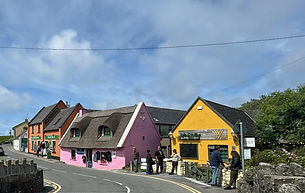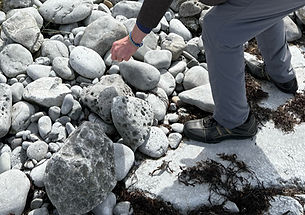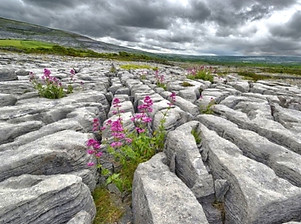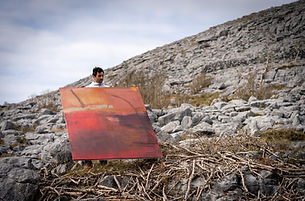Read my NYTimes travel article: “Drawn by a Vast Rocky Landscape on Ireland’s West Coast”

About the Burren
If you’re not familiar with the region in west Ireland known as the Burren (pronounced BURR-ən and derived from the Gaelic word “boíreann,” meaning ”stony place“), you’re not alone. Even many of the Irish have only a passing familiarity with it—meaning, they tend to pass by it on their way somewhere else, often following the “Wild Atlantic Way“ scenic route up Ireland’s western coast.
The Burren region consists of about 150 square miles in the upper half of County Clare, running along the Atlantic Coast from just north of the Cliffs of Moher to Galway Bay, and extending inland about 15 to 20 miles. Its marvelous terrain includes scenic mountains, lovely beaches, grassland valleys, hazel woodlands, and, around its perimeter, several small but lively towns. At the center of the region is the six-mile square Burren National Park, the smallest of seven national parks in Ireland. Together with the Cliffs of Moher, the Burren has been designated a UNESCO Global Geopark because of the region’s unique geological features, biodiversity, and cultural heritage.
What the Burren is most known for is its vast limestone expanses, or karst, a term for a landscape shaped by the dissolving action of water on soluble rocks like limestone. This area was once an enclosed tropical sea. As land masses shifted and the water receded, shells of countless sea creatures compressed to form porous limestone surfaces and mountains. The white and gray limestone is highly reflective and changes hue constantly, depending on the weather.
Rare plants above and an underworld below
Sometimes the stone takes the form of smooth, worn slabs, divided by crisscrossing crevices. Sprouting from the crevices between the limestone “pavement” are some of the world’s rarest flowers—Arctic and Alpine plants alongside Mediterranean species, showing up in bright pinks, blues, and purples.
The abundant plant life is nourished by hidden rivers flowing beneath the rocky surface, with the cracks serving as greenhouses. If you listen closely, you can hear the currents rushing underfoot. Below the acres of limestone is an aqueous netherworld of more than two hundred caves—the kind of dark, murky places where Tolkien’s Gollum might have dwelt. (Indeed, JRR Tolkien spent time in the Burren—and may have been inspired by its otherworldly landscape and underground caves, which include a cave named Pol na Gollum.)
In some parts of the Burren, stone forts and tombs, thousands of years old, are still standing, undisturbed. In addition to the built structures, there are thousands of oddly-shaped, huge boulders, known as “erratics”—they hulk there alone in otherwise-open spaces, carried and dropped there fifteen thousand years ago by glaciers.
Depending on where you stand, the Burren may seem desolate and bare—words like “moonscape” are often used to describe it. A British army officer stationed in the Burren during Oliver Cromwell’s campaign of persecution in Ireland in the mid-17th century remarked, “There isn’t a tree to hang a man, water to drown a man, nor soil to bury a man.”
But the Burren’s strange bareness and remoteness is also part of its appeal. It is an amazing place to walk (see my writing on that in the Burren Experiences section.) Whether you like ambling along beaches, climbing up to the hills, or descending into valleys and shady woodlands, there’s a path to suit your tastes.
And, perhaps not surprisingly, the Burren has become a creative haven for artists and all types of creators, some of whom are profiled on this site in the Creatives of the Burren section.











